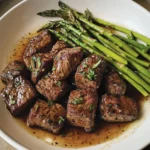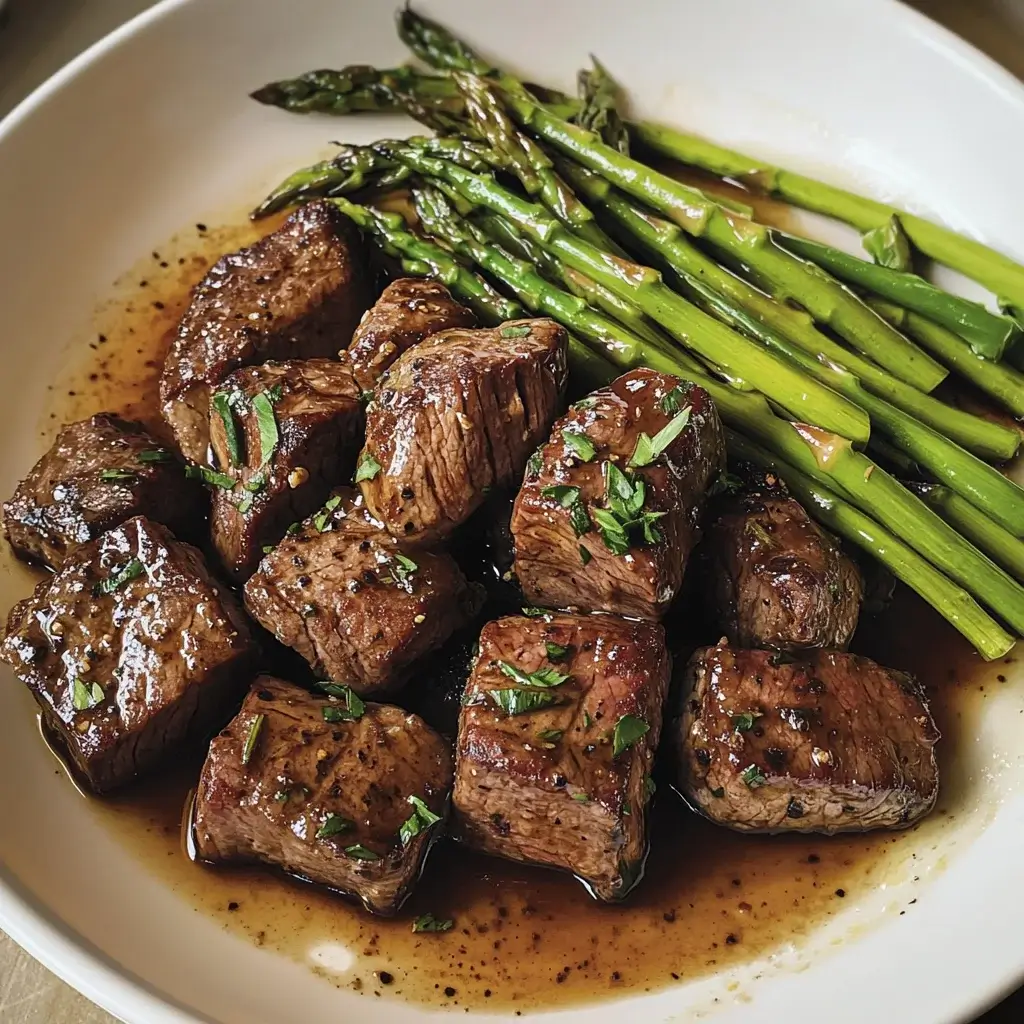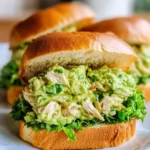The first time I made this Balsamic Glazed Beef and Asparagus, I wasn’t sure what to expect. Weeknight dinners in our house can sometimes feel like a race against the clock, often resulting in repetitive meals. I was searching for something quick, relatively healthy, but packed with flavour – something that felt a little bit special without requiring hours in the kitchen. This recipe ticked all the boxes on paper, but the real test is always the family’s reaction. As the aromas of searing beef, garlic, and the sweet tang of balsamic vinegar filled the kitchen, anticipation started to build. The vibrant green of the asparagus added a beautiful pop of colour to the pan. When I finally served it over steaming rice, the verdict was unanimous: absolute deliciousness. My husband, usually a man of few words when it comes to food praise beyond “it’s good,” actually asked when we could have it again. Even the kids, often suspicious of green vegetables, devoured their portions, chasing every last piece of tender beef coated in that irresistible glaze. It has since become a staple in our meal rotation – a guaranteed crowd-pleaser that makes me feel like a gourmet chef, even on a busy Tuesday night. It’s the perfect balance of savoury, sweet, and tangy, with perfectly cooked, tender-crisp asparagus providing a fresh counterpoint. It’s proof that sophisticated flavours don’t always require complicated techniques or long cooking times.
Ingredients
- 1.5 lbs Beef Sirloin Steak (or Flank Steak/Skirt Steak): Thinly sliced against the grain into bite-sized strips (approx. ¼ inch thick). Using quality beef like sirloin ensures tenderness, while slicing against the grain is crucial for preventing chewiness. Flank or skirt steak are also excellent, flavourful alternatives. Ensure it’s well-trimmed of excess fat.
- 1 lb Fresh Asparagus: Woody ends trimmed, cut into 1.5 to 2-inch pieces. Choose spears that are firm and bright green, avoiding any that look limp or dull. Uniform pieces ensure even cooking.
- 2 Tablespoons Olive Oil (or Avocado Oil): Divided. A neutral-flavoured oil with a relatively high smoke point is needed for searing the beef and sautéing the vegetables.
- 3 Cloves Garlic: Minced. Fresh garlic provides the best aromatic flavour base; about 1 tablespoon minced.
- 1/4 Cup Balsamic Vinegar: Good quality balsamic vinegar is key for the glaze’s flavour depth. Avoid overly thin or imitation varieties. Aged balsamic will offer a richer, sweeter profile.
- 2 Tablespoons Low-Sodium Soy Sauce (or Tamari for Gluten-Free): Adds umami depth and saltiness to balance the sweetness of the glaze. Low-sodium variety helps control the overall salt content. Tamari is a great gluten-free alternative.
- 1 Tablespoon Honey (or Maple Syrup/Brown Sugar): Provides the sweetness for the glaze and helps it caramelize. Adjust slightly based on the sweetness of your balsamic vinegar and personal preference.
- 1 Teaspoon Dijon Mustard: Adds a subtle tang and complexity, helping to emulsify the glaze slightly.
- 1/2 Teaspoon Red Pepper Flakes (Optional): For a gentle touch of heat to contrast the sweetness. Adjust the amount based on your spice tolerance.
- 1 Teaspoon Cornstarch (Mixed with 1 Tablespoon Cold Water): Creates a slurry to thicken the glaze to the perfect coating consistency. Ensure the water is cold to prevent lumps.
- Salt: To taste. For seasoning the beef before cooking.
- Freshly Ground Black Pepper: To taste. For seasoning the beef and adding a pungent kick.
- Sesame Seeds (Optional, for garnish): Toasted sesame seeds add a nutty flavour and visual appeal.
- Fresh Parsley or Chives (Optional, for garnish): Chopped fresh herbs add a touch of freshness and colour before serving.
Instructions
- Prepare the Beef: Pat the thinly sliced beef strips completely dry with paper towels. This step is crucial for achieving a good sear rather than steaming the meat. Season generously with salt and freshly ground black pepper. Set aside while you prepare the other components. Allowing the beef to sit at room temperature for about 15-20 minutes before cooking can also help it sear more evenly.
- Prepare the Glaze: In a small bowl, whisk together the balsamic vinegar, low-sodium soy sauce (or tamari), honey (or maple syrup/brown sugar), Dijon mustard, and optional red pepper flakes. Ensure the honey is fully incorporated. Set this mixture aside.
- Prepare the Cornstarch Slurry: In a separate, very small bowl, whisk together the cornstarch and cold water until completely smooth, with no lumps remaining. Set aside. This will be added later to thicken the sauce.
- Sear the Beef: Heat 1 tablespoon of olive oil in a large skillet or wok over medium-high heat. The oil should shimmer slightly when hot. Add half of the seasoned beef strips to the hot skillet in a single layer, ensuring not to overcrowd the pan. Overcrowding will lower the pan temperature and cause the beef to steam instead of sear. Cook for 1-2 minutes per side, until nicely browned but still slightly pink inside. Work quickly to avoid overcooking. Remove the seared beef from the skillet using a slotted spoon and transfer it to a clean plate. Tent loosely with foil to keep warm. Repeat the process with the remaining 1 tablespoon of olive oil and the second batch of beef strips.
- Sauté Aromatics and Asparagus: Reduce the heat to medium. Add the minced garlic to the same skillet (there should be residual oil and beef drippings – add a tiny bit more oil only if the pan looks completely dry). Sauté the garlic for about 30 seconds until fragrant, being careful not to burn it. Immediately add the trimmed and cut asparagus pieces to the skillet.
- Cook Asparagus: Sauté the asparagus, stirring occasionally, for about 4-6 minutes. The cooking time will depend on the thickness of your asparagus spears. Cook until they are tender-crisp – they should be bright green and retain a slight bite. Avoid overcooking, as mushy asparagus is undesirable. You can add a tablespoon of water or broth to the pan if it seems too dry, helping the asparagus steam slightly while sautéing.
- Create the Glaze: Push the asparagus to one side of the skillet. Pour the prepared balsamic vinegar mixture into the empty side of the skillet. Bring it to a simmer, stirring constantly. Let it bubble gently for about 1-2 minutes, allowing the flavours to meld and slightly reduce.
- Thicken the Glaze: Give the cornstarch slurry a quick re-whisk (as cornstarch can settle). Pour the slurry into the simmering balsamic mixture while whisking continuously. Continue to simmer and whisk for another 1-2 minutes, or until the sauce thickens to a glaze consistency that can coat the back of a spoon. It will thicken further as it cools slightly.
- Combine and Finish: Return the seared beef (and any accumulated juices from the plate) back into the skillet with the asparagus and thickened glaze. Gently toss everything together to ensure the beef and asparagus are evenly coated in the glossy balsamic glaze. Cook for just another 30-60 seconds, allowing the beef to heat through completely. Be careful not to cook much longer at this stage, or the beef may become tough.
- Serve: Remove the skillet from the heat immediately. Taste and adjust seasoning if necessary (though it likely won’t need extra salt due to the soy sauce). Serve the Balsamic Glazed Beef and Asparagus hot. Garnish with toasted sesame seeds and/or chopped fresh parsley or chives, if desired, for added texture and freshness.
Nutrition Facts
(Approximate values based on a standard preparation serving 4 people)
- Servings: 4
- Calories per Serving: Approximately 450-550 kcal. This range depends heavily on the specific cut of beef used (fat content), the amount of oil, and the type/amount of sweetener in the glaze. This provides a substantial portion of daily energy needs.
- Protein: Approximately 35-45g per serving. Primarily from the beef, this dish is an excellent source of high-quality protein, crucial for muscle building, repair, and satiety.
- Fat: Approximately 20-30g per serving. This includes healthy unsaturated fats from olive oil and the natural fats in the beef. The amount varies significantly with the cut of beef chosen (sirloin is leaner than skirt steak).
- Carbohydrates: Approximately 15-20g per serving. Mostly from the balsamic vinegar, honey/sweetener, cornstarch, and natural sugars in the asparagus. Serving over rice or quinoa will increase the carbohydrate count significantly.
- Fiber: Approximately 3-5g per serving. Primarily from the asparagus, contributing to digestive health and helping to moderate blood sugar levels.
(Note: These are estimates. Actual nutritional values can vary based on specific ingredients, brands, and preparation methods. For precise information, using a nutritional calculator with your exact ingredients is recommended.)
Preparation Time
This Balsamic Glazed Beef and Asparagus recipe is designed for efficiency, making it an ideal choice for weeknight meals.
- Prep Time: Approximately 15-20 minutes. This includes trimming and slicing the beef, trimming and cutting the asparagus, mincing the garlic, and whisking together the glaze components and cornstarch slurry. Efficient knife skills can shorten this time.
- Cook Time: Approximately 15-20 minutes. This covers searing the beef in batches, sautéing the garlic and asparagus, simmering and thickening the glaze, and finally combining everything.
- Total Time: Approximately 30-40 minutes. From starting your prep work to having the finished dish ready to serve, this flavourful meal comes together relatively quickly.
How to Serve
This versatile Balsamic Glazed Beef and Asparagus pairs wonderfully with a variety of side dishes to create a complete and satisfying meal. Here are some serving suggestions:
- With Grains:
- Steamed Rice: Fluffy white rice (like Jasmine or Basmati) is a classic pairing, soaking up the delicious balsamic glaze beautifully.
- Brown Rice: A healthier, whole-grain option that adds a nutty flavour and extra fiber.
- Quinoa: A complete protein, gluten-free grain that provides a slightly different texture and nutty undertone. Cooks relatively quickly.
- Farro or Barley: Hearty ancient grains that offer a chewy texture and earthy flavour, standing up well to the rich sauce.
- With Noodles:
- Egg Noodles: Wide or medium egg noodles provide a comforting base, catching the glaze in their folds.
- Soba Noodles: Japanese buckwheat noodles offer a distinct nutty flavour that complements the balsamic glaze surprisingly well.
- Udon Noodles: Thick, chewy wheat noodles provide a substantial and satisfying pairing.
- Low-Carb Options:
- Cauliflower Rice: A popular low-carb and keto-friendly alternative that mimics the texture of rice and absorbs the sauce nicely.
- Zucchini Noodles (Zoodles): Spiralized zucchini provides a fresh, light, vegetable-based alternative. Sauté briefly before serving or serve raw for more crunch.
- Spaghetti Squash: Roasted spaghetti squash strands offer another low-carb “noodle” option.
- On its Own: The dish is flavourful and substantial enough to be enjoyed by itself for a very low-carb meal, perhaps with a side salad.
- Other Accompaniments:
- Mashed Potatoes or Cauliflower Mash: Creamy mash provides a comforting contrast to the tangy glaze and textures of the beef and asparagus.
- Crusty Bread: Perfect for mopping up every last bit of the delicious balsamic glaze from the plate. A good sourdough or baguette works well.
- Simple Side Salad: A light green salad with a simple vinaigrette can offer a refreshing counterpoint to the richness of the main dish.
- Presentation:
- Serve immediately after cooking for the best texture.
- Arrange the beef and asparagus attractively over your chosen base.
- Drizzle any extra glaze from the pan over the top.
- Garnish with toasted sesame seeds for nuttiness and visual appeal, and/or fresh chopped parsley or chives for a pop of colour and freshness.
Additional Tips for Success
- Slice Beef Correctly: Always slice the beef thinly (about ¼ inch) against the grain. Look for the direction the muscle fibers run, and cut perpendicular to them. This shortens the fibers, making the beef significantly more tender and easier to chew, even if using less expensive cuts. Partially freezing the beef for 15-20 minutes can make it much easier to slice thinly and uniformly.
- Don’t Overcrowd the Pan: This is critical for searing the beef properly. Cook the beef in batches if necessary. Adding too much meat at once lowers the pan’s temperature, causing the beef to steam in its own juices instead of developing a flavourful brown crust (Maillard reaction). A good sear locks in juices and adds depth of flavour.
- High Heat for Searing: Ensure your skillet and oil are properly hot before adding the beef. The oil should shimmer, or a small piece of beef should sizzle instantly upon contact. This quick, high-heat cooking sears the outside effectively without overcooking the inside.
- Control Asparagus Cooking: Aim for tender-crisp asparagus. It should be bright green and offer a slight snap when bitten. Overcooked asparagus becomes limp, mushy, and loses its vibrant colour and fresh flavour. Adjust cooking time based on the thickness of the spears. If you prefer very tender asparagus, you can briefly blanch it before adding it to the skillet.
- Glaze Consistency is Key: Don’t walk away while the glaze is simmering and thickening. The cornstarch slurry works quickly. You want a consistency that coats the beef and asparagus nicely without being overly thick or watery. Remember it will thicken slightly more as it cools off the heat. If it gets too thick, whisk in a teaspoon or two of water or broth to loosen it. If too thin, let it simmer a moment longer or add a tiny bit more slurry (mix cornstarch and water first!).
- Taste and Adjust Glaze: Balsamic vinegars vary in sweetness and acidity, and personal preferences differ. Taste the glaze before adding the cornstarch slurry and adjust if needed. Want it sweeter? Add a touch more honey. Tangier? A tiny splash more vinegar (carefully). More umami? A dash more soy sauce.
- Ingredient Variations: Feel free to swap or add vegetables. Broccoli florets, sliced bell peppers (red or yellow work well), snap peas, snow peas, sliced mushrooms, or onions can be added along with the asparagus (adjust cooking times accordingly). You could also substitute chicken breast strips or shrimp for the beef, adjusting cooking times. For a vegetarian version, try firm or extra-firm tofu (pressed and cubed) or tempeh.
- Prep Ahead for Faster Assembly: To make this meal even quicker on a busy night, you can do much of the prep work ahead of time. Slice the beef, trim and cut the asparagus, mince the garlic, and whisk together the balsamic glaze ingredients (keep the cornstarch slurry separate until cooking). Store these components in airtight containers in the refrigerator for up to 24 hours. This turns the cooking process into a simple assembly job.
Frequently Asked Questions (FAQ)
- Q: What is the best cut of beef for Balsamic Glazed Beef and Asparagus?
- A: Sirloin steak is an excellent choice as it’s relatively lean but still tender and flavourful. Flank steak and skirt steak are also fantastic options, known for their robust beefy flavour – just be absolutely sure to slice them thinly against the grain to ensure tenderness. Even cuts like flat iron steak or tenderloin tips can work well. Avoid tougher stewing meats unless you plan to marinate them for an extended period.
- Q: Can I make this recipe gluten-free?
- A: Yes, easily! The main source of gluten is typically the soy sauce. Simply substitute the regular soy sauce with an equal amount of gluten-free tamari or coconut aminos. Ensure your balsamic vinegar and Dijon mustard are also certified gluten-free if you have severe intolerance or celiac disease, though most brands are naturally gluten-free. Cornstarch is naturally gluten-free.
- Q: How can I make this recipe lower in carbohydrates or keto-friendly?
- A: To reduce carbs, replace the honey/maple syrup/brown sugar with a keto-friendly liquid sweetener (like liquid stevia or monk fruit drops) or a granular sweetener like erythritol (adjust to taste). Be mindful that balsamic vinegar does contain natural sugars. Use a good quality one, as cheaper versions sometimes have added sugar. Serve the dish on its own, over cauliflower rice, zucchini noodles, or a bed of greens instead of traditional grains or noodles.
- Q: Can I use frozen asparagus?
- A: While fresh asparagus yields the best texture (tender-crisp), you can use frozen asparagus in a pinch. Do not thaw it first. Add the frozen asparagus pieces directly to the hot skillet after sautéing the garlic. You may need to cook it slightly longer than fresh asparagus, about 6-8 minutes, until heated through and tender. Note that frozen asparagus tends to release more water and may result in a slightly softer texture compared to fresh.
- Q: How do I store and reheat leftovers?
- A: Store any leftovers in an airtight container in the refrigerator for up to 3-4 days. For best results when reheating, gently warm the beef and asparagus in a skillet over medium-low heat until heated through. You can add a splash of water or broth if the sauce seems too thick. Microwaving is also an option, but be careful not to overheat, as this can make the beef tough and the asparagus mushy. Reheat in short intervals, stirring in between.
- Q: Can I freeze Balsamic Glazed Beef and Asparagus?
- A: Freezing is generally not recommended for this dish. While the beef component might freeze okay, cooked asparagus tends to become very soft and watery upon thawing and reheating. The texture of the glaze might also change slightly. If you must freeze it, know that the quality, particularly of the asparagus, will be compromised.
- Q: What other vegetables can I add to this dish?
- A: This recipe is very adaptable! Besides asparagus, great additions include broccoli florets, sliced bell peppers (any colour), sliced onions or shallots, mushrooms (cremini or shiitake), snow peas, snap peas, green beans, or even thinly sliced carrots. Add heartier vegetables like broccoli or carrots a few minutes before the asparagus to ensure they cook through properly.
- Q: Can I make the balsamic glaze ahead of time?
- A: Yes, you can prepare the balsamic glaze mixture (balsamic vinegar, soy sauce, honey, mustard, red pepper flakes – without the cornstarch slurry) ahead of time. Store it in an airtight container or jar in the refrigerator for up to a week. When you’re ready to cook, simply give it a good whisk before using it in step 7, and prepare the cornstarch slurry just before you need to thicken the sauce in step 8. This can be a great time-saver.

Balsamic Glazed Beef and Asparagus
Ingredients
- 1.5 lbs Beef Sirloin Steak (or Flank Steak/Skirt Steak): Thinly sliced against the grain into bite-sized strips (approx. ¼ inch thick). Using quality beef like sirloin ensures tenderness, while slicing against the grain is crucial for preventing chewiness. Flank or skirt steak are also excellent, flavourful alternatives. Ensure it’s well-trimmed of excess fat.
- 1 lb Fresh Asparagus: Woody ends trimmed, cut into 1.5 to 2-inch pieces. Choose spears that are firm and bright green, avoiding any that look limp or dull. Uniform pieces ensure even cooking.
- 2 Tablespoons Olive Oil (or Avocado Oil): Divided. A neutral-flavoured oil with a relatively high smoke point is needed for searing the beef and sautéing the vegetables.
- 3 Cloves Garlic: Minced. Fresh garlic provides the best aromatic flavour base; about 1 tablespoon minced.
- 1/4 Cup Balsamic Vinegar: Good quality balsamic vinegar is key for the glaze’s flavour depth. Avoid overly thin or imitation varieties. Aged balsamic will offer a richer, sweeter profile.
- 2 Tablespoons Low-Sodium Soy Sauce (or Tamari for Gluten-Free): Adds umami depth and saltiness to balance the sweetness of the glaze. Low-sodium variety helps control the overall salt content. Tamari is a great gluten-free alternative.
- 1 Tablespoon Honey (or Maple Syrup/Brown Sugar): Provides the sweetness for the glaze and helps it caramelize. Adjust slightly based on the sweetness of your balsamic vinegar and personal preference.
- 1 Teaspoon Dijon Mustard: Adds a subtle tang and complexity, helping to emulsify the glaze slightly.
- 1/2 Teaspoon Red Pepper Flakes (Optional): For a gentle touch of heat to contrast the sweetness. Adjust the amount based on your spice tolerance.
- 1 Teaspoon Cornstarch (Mixed with 1 Tablespoon Cold Water): Creates a slurry to thicken the glaze to the perfect coating consistency. Ensure the water is cold to prevent lumps.
- Salt: To taste. For seasoning the beef before cooking.
- Freshly Ground Black Pepper: To taste. For seasoning the beef and adding a pungent kick.
- Sesame Seeds (Optional, for garnish): Toasted sesame seeds add a nutty flavour and visual appeal.
- Fresh Parsley or Chives (Optional, for garnish): Chopped fresh herbs add a touch of freshness and colour before serving.
Instructions
- Prepare the Beef: Pat the thinly sliced beef strips completely dry with paper towels. This step is crucial for achieving a good sear rather than steaming the meat. Season generously with salt and freshly ground black pepper. Set aside while you prepare the other components. Allowing the beef to sit at room temperature for about 15-20 minutes before cooking can also help it sear more evenly.
- Prepare the Glaze: In a small bowl, whisk together the balsamic vinegar, low-sodium soy sauce (or tamari), honey (or maple syrup/brown sugar), Dijon mustard, and optional red pepper flakes. Ensure the honey is fully incorporated. Set this mixture aside.
- Prepare the Cornstarch Slurry: In a separate, very small bowl, whisk together the cornstarch and cold water until completely smooth, with no lumps remaining. Set aside. This will be added later to thicken the sauce.
- Sear the Beef: Heat 1 tablespoon of olive oil in a large skillet or wok over medium-high heat. The oil should shimmer slightly when hot. Add half of the seasoned beef strips to the hot skillet in a single layer, ensuring not to overcrowd the pan. Overcrowding will lower the pan temperature and cause the beef to steam instead of sear. Cook for 1-2 minutes per side, until nicely browned but still slightly pink inside. Work quickly to avoid overcooking. Remove the seared beef from the skillet using a slotted spoon and transfer it to a clean plate. Tent loosely with foil to keep warm. Repeat the process with the remaining 1 tablespoon of olive oil and the second batch of beef strips.
- Sauté Aromatics and Asparagus: Reduce the heat to medium. Add the minced garlic to the same skillet (there should be residual oil and beef drippings – add a tiny bit more oil only if the pan looks completely dry). Sauté the garlic for about 30 seconds until fragrant, being careful not to burn it. Immediately add the trimmed and cut asparagus pieces to the skillet.
- Cook Asparagus: Sauté the asparagus, stirring occasionally, for about 4-6 minutes. The cooking time will depend on the thickness of your asparagus spears. Cook until they are tender-crisp – they should be bright green and retain a slight bite. Avoid overcooking, as mushy asparagus is undesirable. You can add a tablespoon of water or broth to the pan if it seems too dry, helping the asparagus steam slightly while sautéing.
- Create the Glaze: Push the asparagus to one side of the skillet. Pour the prepared balsamic vinegar mixture into the empty side of the skillet. Bring it to a simmer, stirring constantly. Let it bubble gently for about 1-2 minutes, allowing the flavours to meld and slightly reduce.
- Thicken the Glaze: Give the cornstarch slurry a quick re-whisk (as cornstarch can settle). Pour the slurry into the simmering balsamic mixture while whisking continuously. Continue to simmer and whisk for another 1-2 minutes, or until the sauce thickens to a glaze consistency that can coat the back of a spoon. It will thicken further as it cools slightly.
- Combine and Finish: Return the seared beef (and any accumulated juices from the plate) back into the skillet with the asparagus and thickened glaze. Gently toss everything together to ensure the beef and asparagus are evenly coated in the glossy balsamic glaze. Cook for just another 30-60 seconds, allowing the beef to heat through completely. Be careful not to cook much longer at this stage, or the beef may become tough.
- Serve: Remove the skillet from the heat immediately. Taste and adjust seasoning if necessary (though it likely won’t need extra salt due to the soy sauce). Serve the Balsamic Glazed Beef and Asparagus hot. Garnish with toasted sesame seeds and/or chopped fresh parsley or chives, if desired, for added texture and freshness.
Nutrition
- Serving Size: one normal portion
- Calories: 550
- Fat: 30g
- Carbohydrates: 20g
- Fiber: 5g
- Protein: 45g






